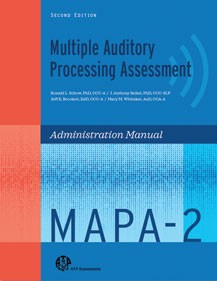Multiple Auditory Processing Assessment (MAPA-2)
Complete Kit
- Ages 7 through 14
- Administration Individual
- Testing Time 30 - 40 minutes
- Copyright 2018
-
Product Code 2211-8 ( MR #067344 )
* Qualifications required to purchase this item. Click here to complete the qualifications form.
Price $235.00
Contents
-

Multiple Auditory Processing Assessment (MAPA-2)
MAPA-2 Administration Manual
$88.00 -

Multiple Auditory Processing Assessment (MAPA-2)
MAPA-2 Record Forms (25)
$50.00 -

Multiple Auditory Processing Assessment (MAPA-2)
MAPA-2 Administration CD
$82.00 -

Multiple Auditory Processing Assessment (MAPA-2)
MAPA-2 Scale of Auditory Behaviors (25)
$15.00
- Monaural: Evaluate an individual’s ability to use low redundancy information.
- Monaural-Selective Attention Test (MSAAT): Assesses an individual’s ability to recognize monosyllabic words with and without competing background noise of high-interest speech
- Speech in Noise for Children (SINCA): Assesses an individual’s ability to recognize monosyllabic word pairs presented with competing pink noise at progressively decreasing signal-to-noise ratios
- Temporal: Evaluate an individual’s ability to use acoustic information over time.
- Tap Test: Assesses an individual’s ability to recognize and label an auditory pattern
- Pitch Pattern Test: Assesses an individual’s ability to use cues including rate and pattern and to label what is heard
- Binaural: Evaluate an individual’s ability to use unique information presented simultaneously to each ear.
- Dichotic Digits: Assesses an individual’s ability to recognize digit sequences when digit pairs are presented simultaneously to each ear
- Competing Sentences: Assesses an individual’s ability to recognize more complex language sequences presented simultaneously to each ear
- Supplemental Subtests: Additional tests that can be used to assess an individual’s skill in the temporal area.
- Duration Pattern Test: Assesses an individual’s ability to use cues including rate and pattern and to label what is heard
- Gap Detection Test: Assesses an individual’s temporal resolution abilities using intervals of varying length between stimuli
- Cronbach’s Alpha values ranged from 0.71 to 0.93 for the Domains and Overall scores.
- Test-retest correlations ranged from 0.82 to 0.98 for the Domains and Overall scores.
- Factor analyses support the three domain structure of the MAPA-2.
- Validity studies demonstrated that the MAPA-2 is able to identify listening challenges in individuals with ADHD, auditory processing disorder, learning disability, and language impairment.
-

Multiple Auditory Processing Assessment (MAPA-2)
MAPA-2 Administration Manual
$88.00 -

Multiple Auditory Processing Assessment (MAPA-2)
MAPA-2 Record Forms (25)
$50.00 -

Multiple Auditory Processing Assessment (MAPA-2)
MAPA-2 Administration CD
$82.00 -

Multiple Auditory Processing Assessment (MAPA-2)
MAPA-2 Scale of Auditory Behaviors (25)
$15.00
No additional information available for this item.

 Proud to be Canadian
Proud to be Canadian